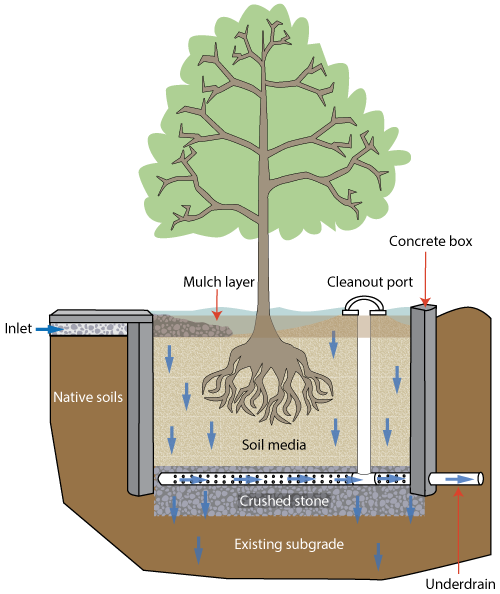
Protecting our environment, one stormwater practice at a time.
Tree Box Filters
Overview
Tree box filters feature an underground precast or cast-in-place concrete structure and an above-ground planting. Plantings typically include small trees and shrubs. Tree box filters are a type of bioretention practice which uses a combination of mulch, engineered soil media and plant roots to treat stormwater runoff. Tree box filters are best suited for areas that do not receive high levels of sediment such as parking lots, courtyards and privately maintained roads. Common features include an inlet where runoff enters a concrete box filled with engineered soil media, a grate similar to those found on urban street trees and an underdrain that connects to the storm drainage system.
 How Tree Box Filters Work
How Tree Box Filters Work
During a rain event, runoff enters the tree box filter through the inlet, much like a traditional street drain. Many tree box filters incorporate an energy dissipator, such as stones, to slow down the water and to catch sediment. The runoff filters through the mulch and engineered soil media. The plant absorbs water and nutrients through its root system. The environment inside the box is well suited for water quality treatment. Biological and chemical reactions take place in the engineered soil media, mulch and root zone to naturally remove nutrients, bacteria, metals and total suspended solids similar to a bioretention facility. Underneath the soil media is a bed of stone where the underdrain lies. The underdrain is a perforated PVC pipe where treated water is conveyed to the storm drainage system. Stormwater that exceeds the tree box filter’s capacity flows past the tree box filter into a standard gutter and eventually into the storm drainage system.
Illustration of the above process courtesy of the University of New Hampshire Stormwater Center.

How to Maintain a Tree Box Filter
Plant Care
Using native plants reduces long-term maintenance and provides habitat and a food source for wildlife.
- Check for dead, diseased or missing vegetation twice a year
- Replant in spring and fall to maintain vegetation
- Maintain at least three inches of mulch and replace twice a year
- Prune in early spring
- Water once weekly during the first two months, then as needed during the growing season
- Do not apply fertilizers or pesticides
- Avoid applying deicing materials that will drain directly into the facility
Regular Maintenance
- Inspect the facility twice per year
- Remove sediment, leaves and trash, as needed
- Inspect the overflow pipe for damage and function
- Inspect the tree box filter after each major storm event (1/2 inch of rain or more). If excessive volumes of stormwater are bypassing the tree box filter or if the box holds water beyond two days, the system is likely clogged. In this case, corrective measures should be taken to restore performance, including inspection and removal of accumulated sediment and debris. Where the condition of the soil media has degraded significantly, the media and vegetation should be removed and replaced.
Suggested Maintenance Timeline
Remove Sediment & Debris: All year long
Remove Trash: All year long
Pruning: March
Mulching: April and October
Replanting: April and October
Watering: As needed, all year long
FairFacts
- There are more than 200 tree box filters installed in the county. Tree box filters may be found at local schools and libraries.
- Flowering Dogwoods (Cornus florida) are a native species that thrive in tree box filters. The flowering dogwood is the state flower and the state tree of Virginia.
- Although native species such as Eastern Redbud and Serviceberry are recommended for planting in tree box filters, other common non-native species that are appropriate for planting in Fairfax County include the Star Magnolia, Upright European Hornbeam and Kousa Dogwood.
- Plants that grow taller than an average of 15 to 25 feet are not recommended for tree box filters because they will become root bound and need replacing more frequently.
The information in this fact sheet is general in nature and is not intended to determine maintenance responsibility.
For more information, contact:
Department of Public Works and Environmental Services, Maintenance and Stormwater Management Division
10635 West Drive, Fairfax, VA 22030
703-877-2800, TTY 711
ContactMSMD@fairfaxcounty.gov

